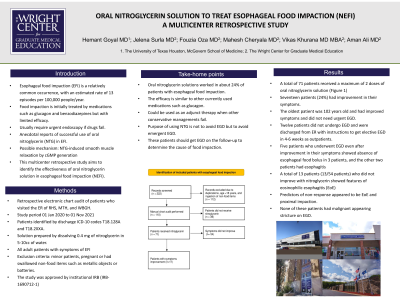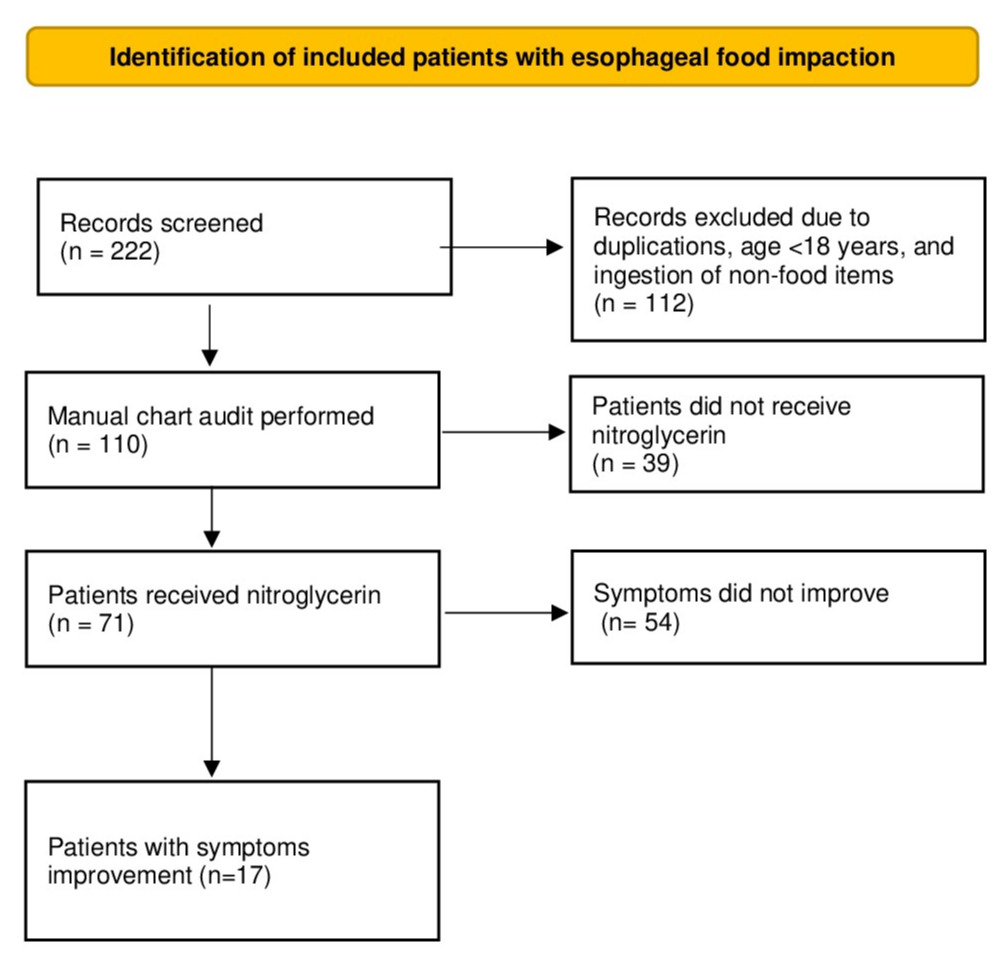Back

Poster Session B - Monday Morning
Category: Esophagus
B0212 - Oral Nitroglycerin Solution to Treat Esophageal Food Impaction (NEFI): A Multicenter Retrospective Study
Monday, October 24, 2022
10:00 AM – 12:00 PM ET
Location: Crown Ballroom


Hemant Goyal, MD
University of Texas McGovern Medical School
Houston, TX
Presenting Author(s)
Hemant Goyal, MD1, Jelena Surla, MD2, Fouzia Oza, MD2, Mahesh Cheryala, MD, MRCP2, Vikas Khurana, MD2, Aman Ali, MD2
1University of Texas McGovern Medical School, Houston, TX; 2The Wright Center for Graduate Medical Education, Scranton, PA
Introduction: Esophageal food impaction (EFI) is a relatively common occurrence, with estimated 13 episodes/100,000 people/year. It is initially treated with a trial of medications, such as glucagon and benzodiazepines; however, with limited success. Patients usually require an urgent endoscopy if these drugs fail. Recently, anecdotal reports of successful use of oral nitroglycerin (NTG) in EFI have been reported. The possible mechanism is NTG-induced smooth muscle relaxation by cGMP generation. However, a single-arm study found that oral NTG alleviated EFI symptoms in only 2 of the 17 subjects, and EGD showed the presence of food bolus in 12 out remaining 15 patients. This multicenter retrospective study aims to identify the effectiveness of oral NTG in EFI patients.
Methods: This is a retrospective chart audit of patients who visited ER of 3 community hospitals with EFI symptoms from 1Jan 2020 to 1Nov 2021. Patients were identified by the discharge ICD-10 codes T18.128A and T18.2XXA. Inclusion criteria were adult and non-pregnant patients. Patients were excluded if they had swallowed non-food items such as metallic objects or batteries. The study was approved by IRB (1690712-1).
Results: A total of 71 pts (mean age 62.52yrs) (Figure 1) received a maximum of 2 doses of oral NTG solution (prepared by dissolving 0.4 mg of NTG in 5-10cc of water) orally. Seventeen patients (24%) had improvement in their symptoms. The oldest patient was 102yrs old who had improvement in their symptoms and did not need urgent EGD. Twelve patients did not undergo EGD and were discharged from the ER with instructions to get elective EGD in 4-6 weeks as outpatients. Five patients who underwent EGD even after improvement in their symptoms showed the absence of food bolus in 3 patients, and the other two patients had esophagitis. A total of 13 patients (13/54 patients) who did not improve with NTG showed features of eosinophilic esophagitis. None of these patients had malignant appearing stricture on EGD. Predictors of non-response appeared to be a history of EoE and proximal impaction.
Discussion: Oral NTG solution worked in about 24% of pts presenting to ER with EFI. The efficacy of oral NTG appears to be similar to other currently used medications such as glucagon, and it can be used as an adjunct therapy when other conservative managements fail. The purpose of using NTG is not to avoid EGD but to avoid emergent EGD. Therefore, these patients should undergo EGD on the follow-up to determine the cause of food impaction.

Disclosures:
Hemant Goyal, MD1, Jelena Surla, MD2, Fouzia Oza, MD2, Mahesh Cheryala, MD, MRCP2, Vikas Khurana, MD2, Aman Ali, MD2. B0212 - Oral Nitroglycerin Solution to Treat Esophageal Food Impaction (NEFI): A Multicenter Retrospective Study, ACG 2022 Annual Scientific Meeting Abstracts. Charlotte, NC: American College of Gastroenterology.
1University of Texas McGovern Medical School, Houston, TX; 2The Wright Center for Graduate Medical Education, Scranton, PA
Introduction: Esophageal food impaction (EFI) is a relatively common occurrence, with estimated 13 episodes/100,000 people/year. It is initially treated with a trial of medications, such as glucagon and benzodiazepines; however, with limited success. Patients usually require an urgent endoscopy if these drugs fail. Recently, anecdotal reports of successful use of oral nitroglycerin (NTG) in EFI have been reported. The possible mechanism is NTG-induced smooth muscle relaxation by cGMP generation. However, a single-arm study found that oral NTG alleviated EFI symptoms in only 2 of the 17 subjects, and EGD showed the presence of food bolus in 12 out remaining 15 patients. This multicenter retrospective study aims to identify the effectiveness of oral NTG in EFI patients.
Methods: This is a retrospective chart audit of patients who visited ER of 3 community hospitals with EFI symptoms from 1Jan 2020 to 1Nov 2021. Patients were identified by the discharge ICD-10 codes T18.128A and T18.2XXA. Inclusion criteria were adult and non-pregnant patients. Patients were excluded if they had swallowed non-food items such as metallic objects or batteries. The study was approved by IRB (1690712-1).
Results: A total of 71 pts (mean age 62.52yrs) (Figure 1) received a maximum of 2 doses of oral NTG solution (prepared by dissolving 0.4 mg of NTG in 5-10cc of water) orally. Seventeen patients (24%) had improvement in their symptoms. The oldest patient was 102yrs old who had improvement in their symptoms and did not need urgent EGD. Twelve patients did not undergo EGD and were discharged from the ER with instructions to get elective EGD in 4-6 weeks as outpatients. Five patients who underwent EGD even after improvement in their symptoms showed the absence of food bolus in 3 patients, and the other two patients had esophagitis. A total of 13 patients (13/54 patients) who did not improve with NTG showed features of eosinophilic esophagitis. None of these patients had malignant appearing stricture on EGD. Predictors of non-response appeared to be a history of EoE and proximal impaction.
Discussion: Oral NTG solution worked in about 24% of pts presenting to ER with EFI. The efficacy of oral NTG appears to be similar to other currently used medications such as glucagon, and it can be used as an adjunct therapy when other conservative managements fail. The purpose of using NTG is not to avoid EGD but to avoid emergent EGD. Therefore, these patients should undergo EGD on the follow-up to determine the cause of food impaction.

Figure: Figure 1: Identification of included patients with esophageal food impaction
Disclosures:
Hemant Goyal: Aimloxy LLC – Consultant.
Jelena Surla indicated no relevant financial relationships.
Fouzia Oza indicated no relevant financial relationships.
Mahesh Cheryala indicated no relevant financial relationships.
Vikas Khurana: Aimloxy LLC – Owner/Ownership Interest.
Aman Ali indicated no relevant financial relationships.
Hemant Goyal, MD1, Jelena Surla, MD2, Fouzia Oza, MD2, Mahesh Cheryala, MD, MRCP2, Vikas Khurana, MD2, Aman Ali, MD2. B0212 - Oral Nitroglycerin Solution to Treat Esophageal Food Impaction (NEFI): A Multicenter Retrospective Study, ACG 2022 Annual Scientific Meeting Abstracts. Charlotte, NC: American College of Gastroenterology.
